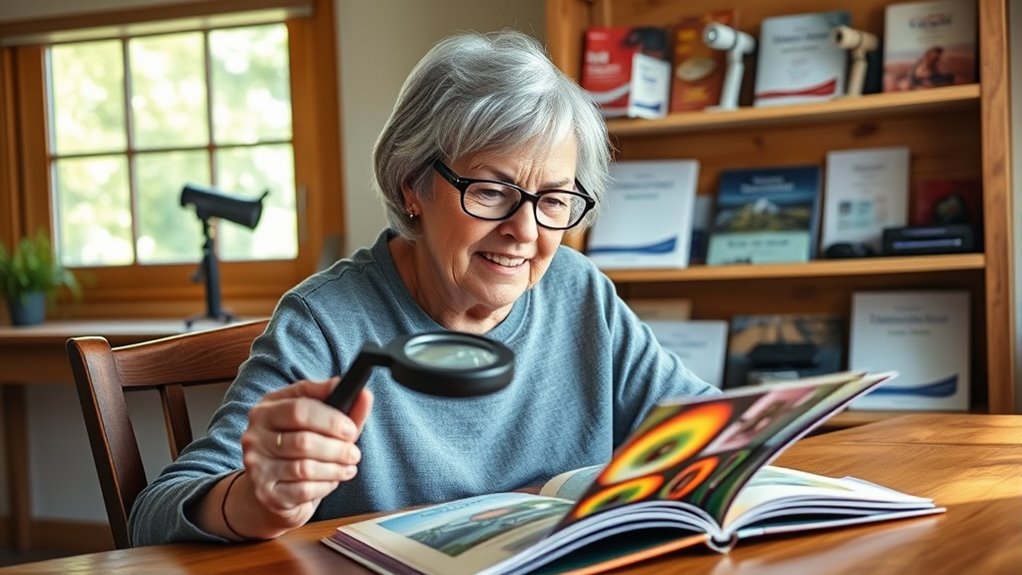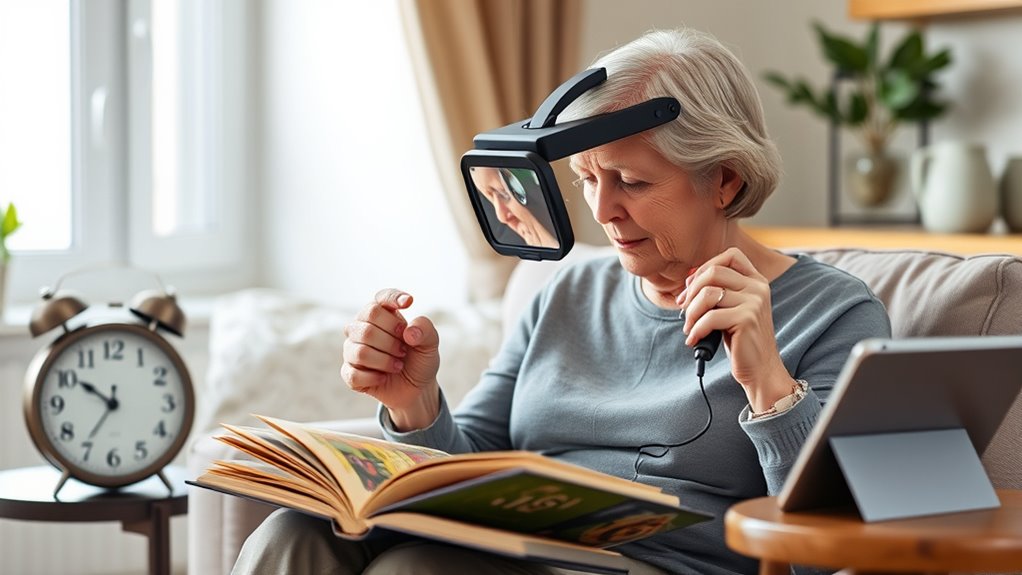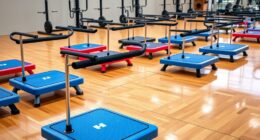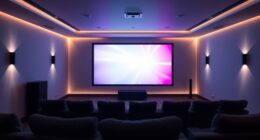To maximize your remaining sight, explore various low-vision aids like magnifiers, electronic devices, and high-contrast lighting. Assess your daily needs and consult eye care professionals to find the best tools for you. Properly using and maintaining these devices can improve your independence and comfort. Simple adjustments like good lighting and organization make a big difference. Keep exploring options and tips to make the most of your vision—more helpful information awaits if you continue.
Key Takeaways
- Assess individual needs and daily activities to select appropriate magnification and contrast-enhancing devices.
- Use adjustable electronic magnifiers and CCTV systems for flexible, customized visual support.
- Optimize lighting conditions and reduce glare to improve visibility and reduce eye strain.
- Incorporate high-contrast clocks, labels, and tactile tools to aid identification and orientation.
- Seek professional guidance and explore assistive technology options, including AI tools, for maximizing remaining sight.
Understanding Low-Vision Conditions in Seniors

Understanding low-vision conditions in seniors is essential because age-related changes can markedly affect their daily lives. As you age, your eyesight naturally declines due to factors like reduced light sensitivity, decreased sharpness, and difficulty distinguishing colors. Common conditions such as macular degeneration, glaucoma, diabetic retinopathy, and cataracts impair your ability to see clearly, especially in low-light or complex environments. These issues can make reading, recognizing faces, or orienteering spaces challenging, leading to frustration and safety concerns. Recognizing these signs early helps you seek appropriate evaluations and interventions. Additionally, advancements in projector technology offer innovative solutions to improve visibility for those with low vision. Incorporating creative problem-solving approaches can help adapt to visual limitations and enhance daily functioning. It’s also helpful to understand how magnification aids can support clearer vision in various activities. Proper education on visual aids and their effective use can significantly enhance independence. Keeping abreast of assistive devices can further empower seniors to maintain their quality of life. Keep in mind that low vision isn’t complete blindness but partial loss, which can often be managed with proper strategies and aids, allowing you to maintain independence and quality of life.
Types of Assistive Devices for Enhanced Sight

A variety of assistive devices can considerably improve vision and help you maintain independence. These tools include magnifiers, which enlarge text and images, making reading easier. Handheld magnifiers are portable, perfect for on-the-go use, while stand magnifiers provide stable, hands-free viewing. Electronic devices, like video magnifiers or CCTV systems, offer adjustable zoom and contrast settings to suit your needs. Brightness and contrast-tuned reading lamps can also reduce eye strain. Additionally, high-contrast clocks, watches, and labeling systems help you identify everyday items more easily. Some devices are designed for specific tasks, such as talking watches or large-button remote controls. These devices work together to enhance your sight, making daily activities more manageable and boosting your confidence. Incorporating assistive technology can further optimize your vision support and independence. Advances in vision enhancement devices continue to improve the quality of life for seniors. For example, using HEPA filtration air purifiers with advanced filtering technology can help reduce indoor allergens, which may indirectly benefit those with eye sensitivities. YouGoNews can provide further insights into advancements in assistive technology for seniors.
How to Choose the Right Low-Vision Aids

Choosing the right low-vision aids depends on your specific needs and daily routines. Start by evaluating what activities you struggle with most, whether reading, recognizing faces, or seeing objects clearly. Consider the magnification levels you need; some devices offer simple magnifiers, while others provide electronic zoom features. Think about portability and ease of use—if you’re often on the go, lightweight and straightforward tools are best. Consult with an eye care professional who can recommend devices tailored to your vision loss level and lifestyle. Also, appraise your comfort with technology—some aids require digital skills, while others are more intuitive. Ultimately, selecting the right aid means finding a balance between functionality, convenience, and your personal preferences. Incorporating assistive technologies such as AI-driven magnifiers and smart devices can further enhance your ability to maximize remaining sight. As advancements in AI in Education continue, innovative tools like intelligent tutoring systems are emerging to support learning and adaptation for users with visual impairments.
Practical Tips for Using Low-Vision Devices Effectively

To get the most benefit from your low-vision devices, it’s important to incorporate some practical habits into your daily routine. Always keep your devices clean and in good condition to ensure clear vision. Use proper lighting; bright, even light helps reduce glare and shadows that can interfere with sight. Take time to familiarize yourself with how each device works, practicing regularly to build confidence. When reading or doing detailed work, position the device at the right distance and angle for ideal clarity. Don’t rush; slow, deliberate movements help you see better and avoid mistakes. Keep your workspace organized, with frequently used items within easy reach. Regularly checking your indoor air quality can help create a healthier environment that supports your eye health and overall well-being. Additionally, maintaining good lifestyle habits such as a balanced diet and proper hydration can contribute to healthier eyes and better vision. Understanding the importance of systematic vulnerability assessments can help you identify potential issues with your devices and environment, enhancing safety and efficiency. Being aware of headphone compatibility is also helpful if you use assistive audio devices, ensuring they work effectively with your low-vision aids. Incorporating dog names can sometimes make your daily routines more enjoyable and personalized, especially if you have a service or therapy dog. Consistent use and proper maintenance will maximize your remaining sight and make daily tasks easier.
Resources and Support for Seniors With Vision Impairment

Support for seniors with vision impairment is widely available through a variety of resources designed to enhance independence and quality of life. Local organizations often offer vision rehabilitation services, including training on how to use low-vision aids effectively. You can also access support groups where you share experiences and gain encouragement from others facing similar challenges. Many government programs provide financial assistance or free devices to eligible seniors. Additionally, optometrists and ophthalmologists can connect you with specialist services tailored to your needs. Online resources, including instructional videos and forums, help you learn practical tips and stay informed about new technologies. Remember, reaching out for support is a proactive step toward maintaining your independence and adapting to vision changes confidently.
Frequently Asked Questions
Can Low-Vision Aids Improve Night Vision for Seniors?
You might wonder if low-vision aids can improve night vision for seniors. While these devices mainly enhance daytime sight, some aids like magnifiers and filters can help reduce glare and improve contrast in low light. However, they don’t directly enhance night vision. For better night vision, you should consider additional strategies such as using brighter lighting and consulting an eye specialist for tailored solutions.
Are There Affordable Low-Vision Devices Available for Seniors on Fixed Incomes?
You’re asking if affordable low-vision devices exist for seniors on fixed incomes. The answer is yes—there are budget-friendly options like magnifying glasses, handheld devices, and smartphone apps designed to help. These tools won’t break the bank, making it easier for seniors to stay independent and see better. Shopping around and consulting with an eye care professional can help you find the most effective, affordable solutions—sometimes, a little goes a long way.
How Often Should Low-Vision Aids Be Replaced or Upgraded?
You should replace or upgrade your low-vision aids when they no longer meet your needs, become damaged, or if newer technology offers better functionality. Typically, devices are updated every few years, but it depends on how often you use them and advancements in technology. Regular check-ins with your eye care professional can help determine the right timing, ensuring you get the most benefit from your aids.
Do Low-Vision Aids Require Special Maintenance or Cleaning?
You should regularly clean and maintain your low-vision aids to guarantee they work effectively. Use a soft, damp cloth to wipe screens and lenses, avoiding harsh chemicals that could damage them. Keep devices free of dust and debris, and check for any signs of wear or damage. Following the manufacturer’s instructions for care helps prolong their lifespan and keeps your vision assistance reliable.
Can Low-Vision Devices Be Used Alongside Other Assistive Technologies?
You might think assistive devices work best alone, but in reality, they often work better together. Using low-vision aids alongside other technologies, like magnifiers or screen readers, enhances your ability to see and access information. These tools complement each other, filling in gaps and providing a more thorough support system. So, yes, combining low-vision devices with other assistive tech can substantially improve your independence and quality of life.
Conclusion
By embracing low-vision aids, you’re opening a window to a brighter world where your remaining sight becomes a guiding light. These tools act as your trusted compass, helping you navigate daily life with confidence and independence. Remember, even a small spark can ignite hope and clarity. With the right support and devices, you’re not just adapting—you’re illuminating the path ahead, turning challenges into opportunities for renewed vision and vibrant living.









